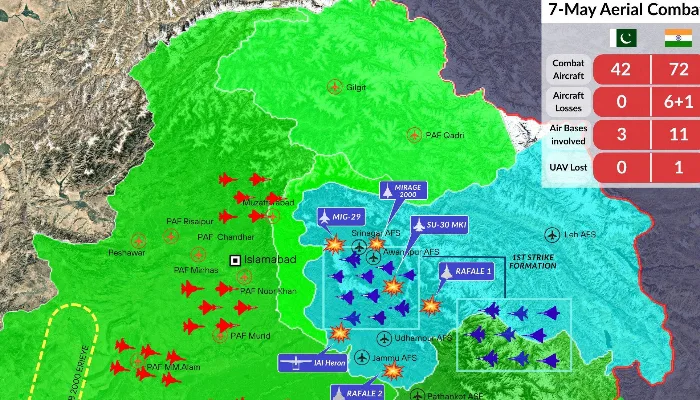The Global Defence Agency is calling it the “most modern aerial clash of the century.” On the night of May 7, Pakistan Air Force (PAF) and Indian Air Force (IAF) engaged in a high-intensity dogfight that lasted nearly one hour. A global defence agency shared the details along with an image on X (formerly Twitter).
The combat unfolded over contested airspace and involved state-of-the-art 4.5-generation fighter jets. According to the shared breakdown, Pakistan successfully downed six Indian aircraft during the confrontation.
Precision Meets Power
The aerial clash began shortly after 10:30 PM Pakistan Standard Time. The IAF initiated the conflict by flying multiple squadrons near the Line of Control (LoC). Within minutes, PAF scrambled its fighter jets and responded with force.
According to the breakdown, Pakistan deployed a mix of JF-17 Thunders and F-16s. Indian forces flew Rafales, SU-30MKIs, and Mirage-2000 jets.
In a swift counter-strike, PAF pilots locked targets with precision-guided missiles. By 11:15 PM, three Indian jets had been downed. The remaining jets tried to retreat but were intercepted before exiting the engagement zone.
Global Military Watchers React
Military analysts around the world are calling the dogfight “unprecedented.” Never before had two nuclear-armed nations engaged in such a high-tech, high-speed aerial showdown in real-time.
The global defence agency posting the update on X described it as “a clash that changed the future of air warfare in South Asia.”
Experts noted that both sides used electronic warfare tactics, radar jamming, and beyond-visual-range (BVR) missiles. But PAF’s tactical advantage, quick coordination, and precision strikes gave it the upper hand.
Indian Losses Confirmed
Indian military sources reluctantly acknowledged the loss of multiple aircraft. Three Rafale jets, two SU-30s, and one Mirage-2000 were confirmed downed. Dozens of drones were also reportedly disabled or destroyed during the operation.
Pakistan’s Inter-Services Public Relations (ISPR) confirmed the kill count and praised the pilots for their skill and bravery. No losses were reported on the Pakistani side.
Ishaq Dar Begins Key China Visit Amid Regional Tensions
Public Reaction and Strategic Implications
The event has sparked massive discussion online. Hashtags like #PAFvsIAF, #May7AirBattle, and #AerialClash2025 have trended globally. Netizens hailed the professionalism of the Pakistan Air Force.
Analysts believe this clash has long-term implications for regional stability. The use of advanced airpower signals a shift in future combat strategies. It also raises concerns about escalation between two longtime rivals.
The May 7 dogfight between PAF and IAF marks a turning point in aerial warfare in the region. The clash was not just about firepower but precision, technology, and tactical dominance.
Pakistan’s decisive performance under pressure has drawn praise, while India faces hard questions about its air defence strategy.
Follow us on Google News, Instagram, YouTube, Facebook,Whats App, and TikTok for latest updates
